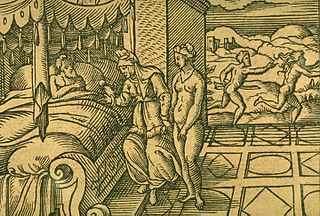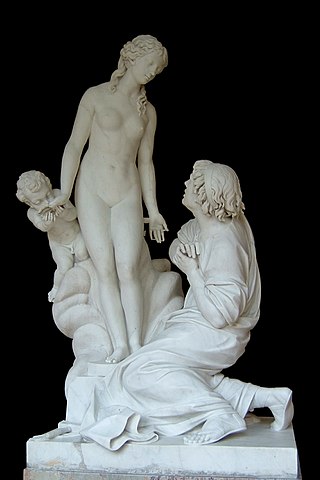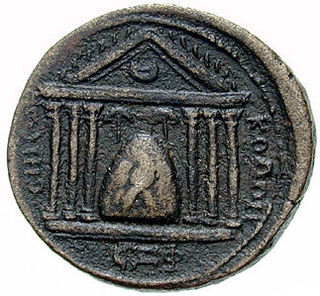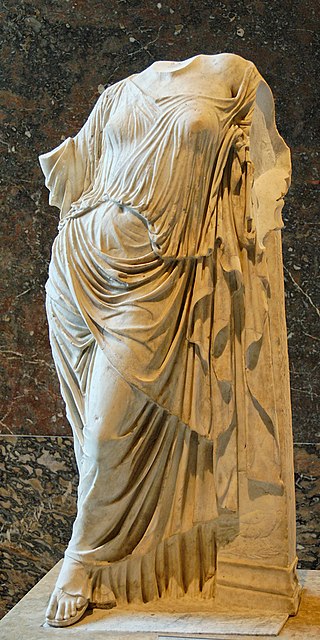
Aphrodite is an ancient Greek goddess associated with love, lust, beauty, pleasure, passion, procreation, and as her syncretized Roman goddess counterpart Venus, desire, sex, fertility, prosperity, and victory. Aphrodite's major symbols include seashells, myrtles, roses, doves, sparrows, and swans. The cult of Aphrodite was largely derived from that of the Phoenician goddess Astarte, a cognate of the East Semitic goddess Ishtar, whose cult was based on the Sumerian cult of Inanna. Aphrodite's main cult centers were Cythera, Cyprus, Corinth, and Athens. Her main festival was the Aphrodisia, which was celebrated annually in midsummer. In Laconia, Aphrodite was worshipped as a warrior goddess. She was also the patron goddess of prostitutes, an association which led early scholars to propose the concept of "sacred prostitution" in Greco-Roman culture, an idea which is now generally seen as erroneous.

Amathus or Amathous was an ancient city and one of the ancient royal cities of Cyprus until about 300 BC. Some of its remains can be seen today on the southern coast in front of Agios Tychonas, about 24 miles (39 km) west of Larnaca and 6 miles (9.7 km) east of Limassol. Its ancient cult sanctuary of Aphrodite was the second most important in Cyprus, her homeland, after Paphos.

Ares is the Greek god of war and courage. He is one of the Twelve Olympians, and the son of Zeus and Hera. The Greeks were ambivalent towards him. He embodies the physical valor necessary for success in war but can also personify sheer brutality and bloodlust, in contrast to his sister Athena, whose martial functions include military strategy and generalship. An association with Ares endows places, objects, and other deities with a savage, dangerous, or militarized quality.

In Greek mythology, Cinyras was a famous hero and king of Cyprus. Accounts vary significantly as to his genealogy and provide a variety of stories concerning him; in many sources he is associated with the cult of Aphrodite on Cyprus, and Adonis, a consort of Aphrodite, is mentioned as his son. Some scholars have proposed a connection with the minor Ugaritic deity Kinnaru, the god of the lyre. The city Cinyreia on Cyprus was believed to have taken its name from Cinyras. According to Strabo, he had previously ruled in the city of Byblos in Phoenicia.

Religious practices in ancient Greece encompassed a collection of beliefs, rituals, and mythology, in the form of both popular public religion and cult practices. The application of the modern concept of "religion" to ancient cultures has been questioned as anachronistic. The ancient Greeks did not have a word for 'religion' in the modern sense. Likewise, no Greek writer known to us classifies either the gods or the cult practices into separate 'religions'. Instead, for example, Herodotus speaks of the Hellenes as having "common shrines of the gods and sacrifices, and the same kinds of customs."

Paphos is a coastal city in southwest Cyprus and the capital of Paphos District. In classical antiquity, two locations were called Paphos: Old Paphos, today known as Kouklia, and New Paphos. It is the fourth-largest city in the country, after Nicosia, Limassol and Larnaca, with an urban population of 63,600 in 2018.

Astarte is the Hellenized form of the Ancient Near Eastern goddess ʿAṯtart. ʿAṯtart was the Northwest Semitic equivalent of the East Semitic goddess Ishtar.

Galatea is a name popularly applied to the statue carved of ivory alabaster by Pygmalion of Cyprus, which then came to life in Greek mythology.

Idalion or Idalium was an ancient city in Cyprus, in modern Dali, Nicosia District. The city was founded on the copper trade in the 3rd millennium BC. Its name does not appear, however, on the renowned "Kition Stele", i.e., the Sargon Stele of 707 BC, but a little later on the Prism of Esarhaddon known as Niniveh A wherein the name is prefixed by the modifier URU (city) as URU.e-di-ʾi-il and in similar spellings in Ashurbanipal's annal while modified by KUR (land/kingdom).

Baetylus are sacred stones which were supposedly endowed with life, or gave access to a deity. According to ancient sources, at least some of these objects of worship were meteorites, which were dedicated to the gods or revered as symbols of the gods themselves.

Kouklia is a village in the Paphos District, about 16 kilometres (9.9 mi) east from the city of Paphos on the Mediterranean island of Cyprus. The village is built in the area of "Palaepaphos", mythical birthplace of Aphrodite, Greek goddess of love and beauty, which became the centre for her worship in the ancient world. Because of its ancient religious significance and architecture, Kouklia was inscribed on the UNESCO World Heritage List along with Kato Paphos in 1980.
In Greek mythology, Agapenor was a leader of the Arcadians in the Trojan war.
In ancient Greek religion, Kanathos in the Argolid was the spring at Nauplia, where Hera annually renewed her virginity. There, Pausanias noted, was "a spring called Kanathos where, so say the Argives, Hera bathes every year and, by so doing, becomes a maiden; it is this story which is of the secrets connected with the rites which they perform to Hera." The unspoken nature of the ritual forbade its being embodied openly or directly in Greek mythology. S. Casson suggested that it was the obscure subject of the so-called "Ludovisi Throne", generally considered to represent the parallel, and far better-known, renewal of Aphrodite, bathing in the sea at Paphos.
In Greek mythology, Eucleia or Eukleia was the female personification of glory and good repute.

Roman Cyprus was a small senatorial province within the Roman Empire. While it was a small province, it possessed several well known religious sanctuaries and figured prominently in Eastern Mediterranean trade, particularly the production and trade of Cypriot copper. The island of Cyprus was situated at a strategically important position along Eastern Mediterranean trade routes, and had been controlled by various imperial powers throughout the first millennium BC. including: the Assyrians, Egyptians, Persians, Macedonians, and eventually the Romans. Cyprus was annexed by the Romans in 58 BC, but turbulence and civil war in Roman politics did not establish firm rule in Cyprus until 31 BC when Roman political struggles ended by Battle of Actium, and after about a decade, Cyprus was assigned a status of senatorial province in 22 BC. From then until the 7th century AD, Cyprus was controlled by the Romans. Cyprus officially became part of the Eastern Roman Empire in 293 AD.

Aphrodite of the Gardens is an epithet of the Greek goddess Aphrodite. The epithet describes her patronage over vegetation and garden fertility.
The Aphrodisia festival was an annual festival held in Ancient Greece in honor of the goddess of love and beauty, Aphrodite. It took place in several Ancient Greek towns, but was especially important in Attica and on the island of Cyprus, where Aphrodite was venerated with a magnificent celebration. The festival occurred during the month of Hekatombaion, which modern scholars recognize as starting from the third week in July to the third week of August on the Gregorian calendar. Aphrodite was worshipped in most towns of Cyprus, as well as in Cythera, Sparta, Thebes, Delos, and Elis, and her most ancient temple was at Paphos. Textual sources explicitly mention Aphrodisia festivals in Corinth and in Athens, where the many prostitutes that resided in the city celebrated the festival as a means of worshipping their patron goddess. Though no textual sources expressly mention an Aphrodisia festival in Cythera, Thebes, or Elis, it likely occurred since textual and iconographical sources indicate that Aphrodite Pandemos had a cult following in these areas. The Aphrodisia festival was one of the most important ceremonies in Delos, though not much is known about the details of the celebration. The inscriptions merely indicate that the festival required the purchase of ropes, torches and wood, which were customary expenses of all Delian festivals.
Aphrodite Areia or "Aphrodite the Warlike" was a cult epithet of the Greek goddess Aphrodite, in which she was depicted in full armor like the war god Ares. This representation was found in Sparta and Taras. There were other, similarly martial interpretations of the goddess, such as at her Sanctuary at Kythira, where she was worshiped under the epithet Aphrodite Urania, who was also represented as being armed. The epithet "Areia", meaning "warlike", was applied to other gods in addition to Aphrodite, such as Athena, Zeus, and possibly Hermes.
The Temple of Aphrodite Kytherea was a sanctuary in ancient Kythira dedicated to the goddess Aphrodite. It was famous for reportedly being the eldest temple of Aphrodite in Greece. It was dedicated to the goddess under her name and aspect as Aphrodite Ourania and contained a statue of an Armed Aphrodite. The temple is dated to the 6th century BCE. While considered a significant sanctuary, it was described as a small building.
The Cave Sanctuaries of the Acropolis of Athens are the natural fissures in the rock of the Acropolis hill that were used as sites of worship for deities of the Panhellenic pantheon in antiquity. Traditionally a sharp distinction has been drawn between the state religion practised on the summit of the Acropolis and the cult practice of the shrines on the lower slopes. Recently, however, interest has burgeoned in the individual religious experience or personal piety in Greek society of which these cult sites may be the expression. The proceeding description follows the order of the shrines from the Klepsydra at the northwest face of the Acropolis clockwise via the Peripatos round to the foot of the Nike bastion.
















